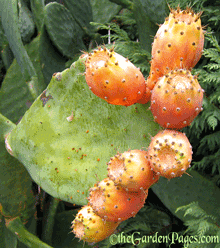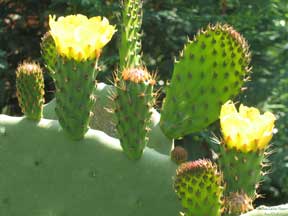
It’s almost time for prickly pears!
I grow a prickly pear cactus (Opuntia ficus-indica) in my back yard and it has great pears. Opuntia cactus also have edible pads, the younger ones are more tender. This cactus variety grows wild in the southwestern United States and Mexico. Prickly pear cactus have deep green branching pads, grow up to 15 feet tall and as wide around in as little as 5 years. The oval cactus pads can be up to three feet long and over a foot across.
In spring my opuntia ficus-indica gets stunning bright yellow to orange flowers measuring 3 to 5 inches across. These turn into pinkish red, edible prickly pears. Over time these cacti form brown, woody trunks.
My opuntia has been happy growing in my adobe-brick-hard, heavy clay soil. It is hardy to 30 degrees below zero. Cattle are also known to have a taste for Opuntia cactus and in some parts of the world it is used as feed after the thorns are removed.
-

Beautiful yellow cactus flowers
Outdoors, prickly pears make very effective security barriers. They can take regular pruning to maintain shape. Always cut at the joints, where the two pads meet. Cuttings can easily be rooted by burying part of a pad in moist, well drained soil after the cut has healed over. Opuntia species have also been known to take root where pads have fallen on the ground – which is exactly how I got mine started. My neighbor threw a cutting over the fence and I was afraid to touch it, so I just nudged it into a good spot and it took root!
Indoors, Opuntia cactus can be grown in pots but they generally don’t grow to more than a few feet tall. They do best in full sunlight with very little water. No cacti like to be over watered and they will rot if they remain in saturated soil. My cactus lets me know when it needs water with thin pads and droopy tips. One year we got over 20 inches of rain and the pads swelled up with so much moisture they broke off under their own weight.
The cactus pads do not have prominent thorns. Instead, they have clumps of small, hair-like needles. It is very easy to get the needles painfully lodged in your skin just by brushing against the pads. Usually the only way to get them out is with tweezers and a magnifying glass. It is recommend to use tongs, a large fork, or cardboard to handle any part of cactus. You should also wear leather gloves or two layers of cotton gloves. The gloves will need to be checked for thorns though, so you may want to avoid handling them using your bare hands.
Cooking Cactus: Cactus pears have the texture of watermelon and a mild, sweet taste like pears or banana. They are high in fiber too. The seeds are black and about the size of a pea. You can also eat the pads raw or cooked. Young, bright green cactus pads are best for eating. Thorns should be washed or scraped off before the cactus skin is peeled.
Use Care When Picking Pears: My neighbor used to eat cactus pears as a boy back in Israel and he taught me how to harvest them without getting pricked. Take a bowl or bucket of water out to the cactus. You should be able to knock the ripe pears off the plant into the water. Use a spoon to roll the pear in the water and scrape the skin. Try not to break the skin. When you think they are clean, it’s time to go rinse them again in the sink. Keep rinsing them until the thorns are gone. The needles are very tiny and hard to see so be very careful. Handle them with gloves until you are positive they’re clean. Bon appetit!